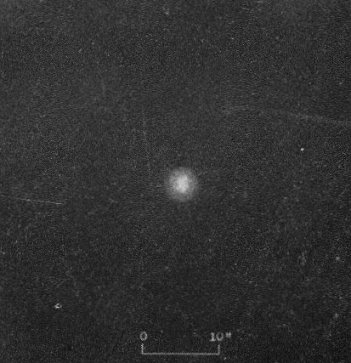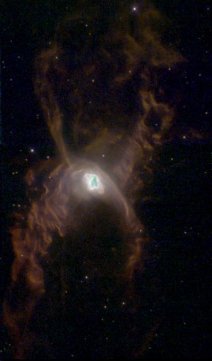NGC 6537
THE RED SPIDER
The comparison between Curtis's composite visual view (left) of NGC
6537 and the Hubble image (right) is among the most severe of any
of the planetary nebulae presented
here. Curtis sees no more than "a minute disk 5" in diameter, just
distinguishable from a star." Hubble shows the minute disk as a
bright core centered on a small halo. The disk in turn is centered
on a huge hourglass-shaped structure that extends outward to a
maximum diameter of 2.5 minutes of arc and that gives the object
its popular name, "The Red Spider," the red color coming from
hydrogen and ionized nitrogen
emissions. Curtis did, however, see the dual structure of the
inner core. Rotate the Hubble image 40 degrees to the left to
place north at the top so as to align the pair of pictues.
NGC 6537 is located in northwestern Sagittarius just 10 degrees to the north-northeast of
the center of the Galaxy (and 2.4 degrees
northwest of Mu Sagittarii), and as such
suffers from considerable dimming by interstellar dust
(interstellar and circumstellar combining to make the object some
40 times dimmer than it would be with no dust present).
One distance measure has it at 3000 light years, while a standard
statistical estimate places it at close to 8000 light years. If we
adopt 5000 as not unreasonable, then the inner core is just a tenth
of a light year across, while the outer assembly extends 3.5 light
years from one extreme edge to the other. The origin of this
strange structure is unknown, but might be related to a magnetic
field discovered within the interior of the nebula that shaped the
wind from the progenitor giant star. A binary companion might have done
it too, but there is no evidence for one.
Buried within the object, the central star is so dim that it is
virtually inaccessible. Curtis could not see one at all, and no
wonder, as it is estimated from nebular properties to shine at
twentieth visual magnitude (19.7) with a luminosity of more than
5000 Suns. The star is so hot, at 250,000 Kelvin one of the
hottest known (more than for NGC 2440 or
7027), that it radiates most of its light
in the far ultraviolet, which with dust absorption renders the
visual magnitude quite faint. The star must be near its maximum
temperature before it enters its final cooling phase to become a
hot white dwarf. The
interior expands relatively leisurely, at 18 kilometers per second,
that and possible rapid evolution of the star rendering the
interior rather small. For now, though, the Red Spider remains
enigmatic.
Left: Image by H. D. Curtis from Publications of the Lick
Observatory, Volume 13, Part III, 1918. Right: Bruce Balick (U.
Washington), Vincent Icke (Lieden U., Netherlands), Garrelt
Mellema, Stockholm U.), and NASA.



